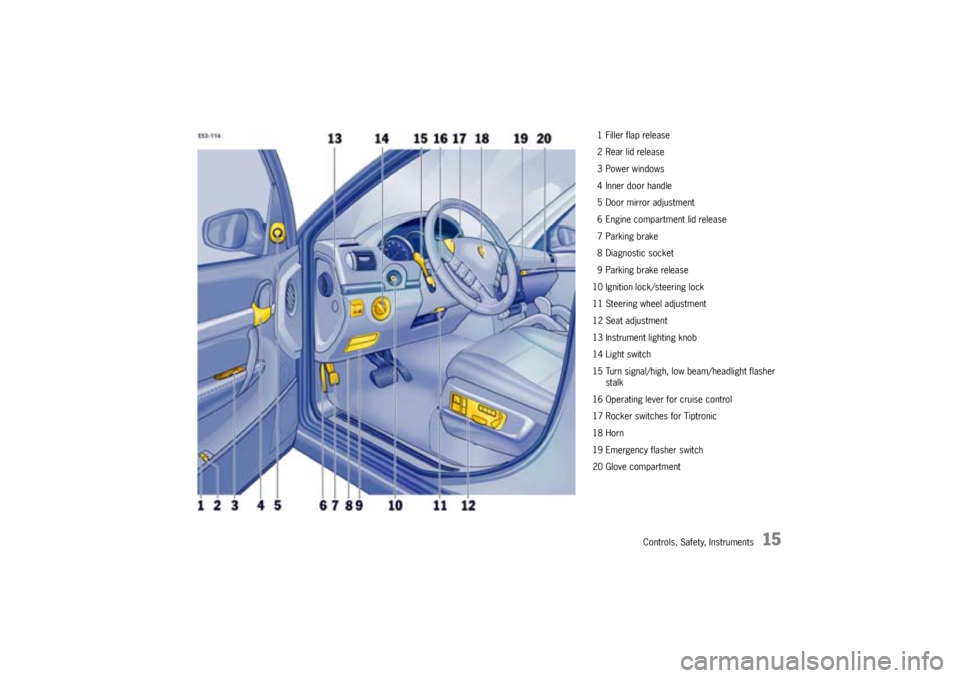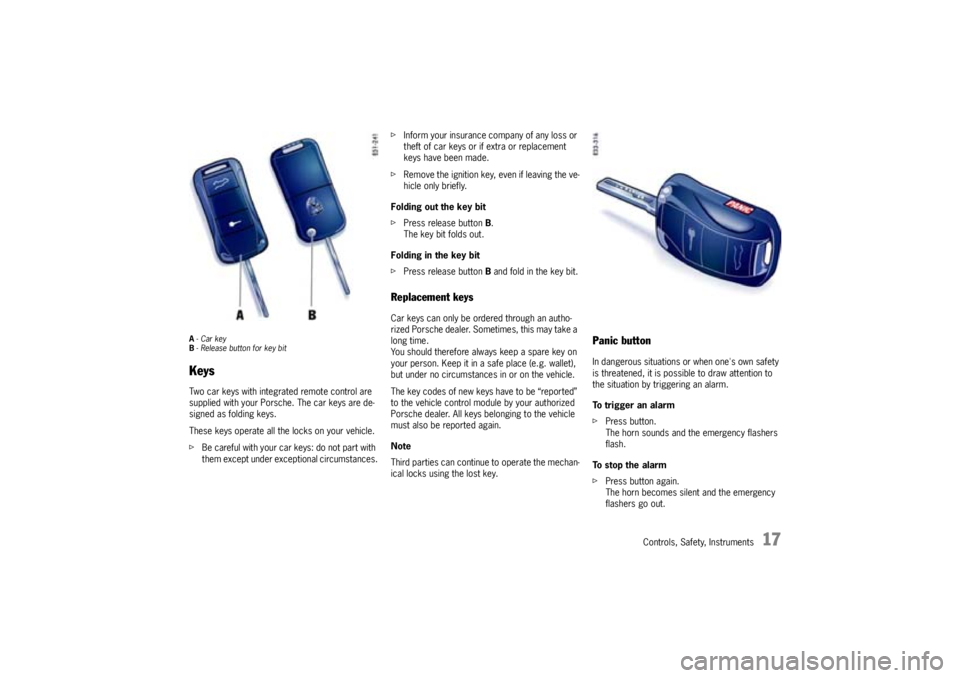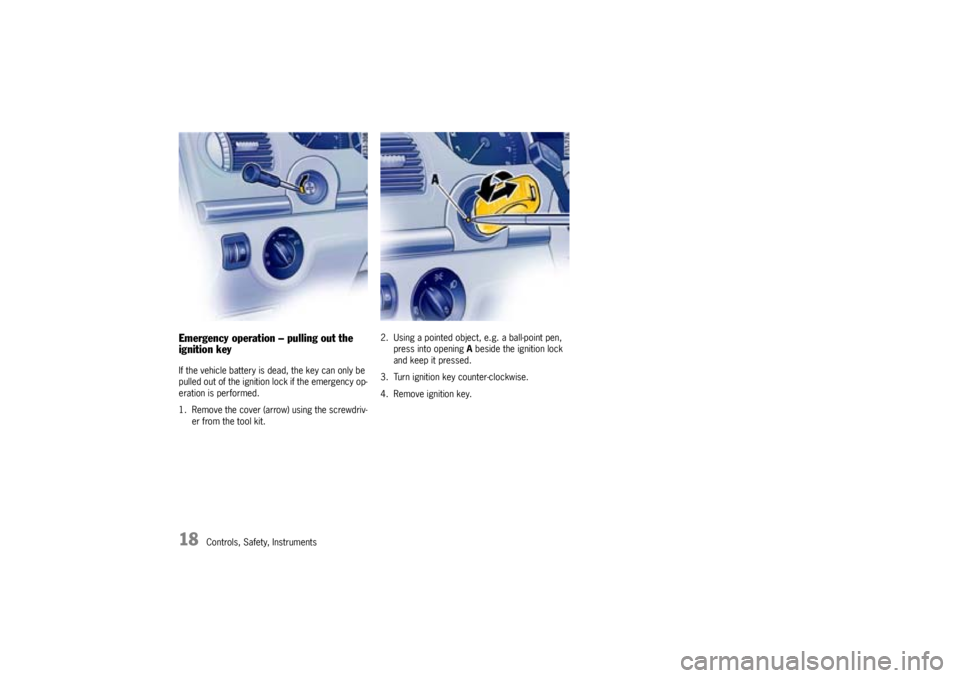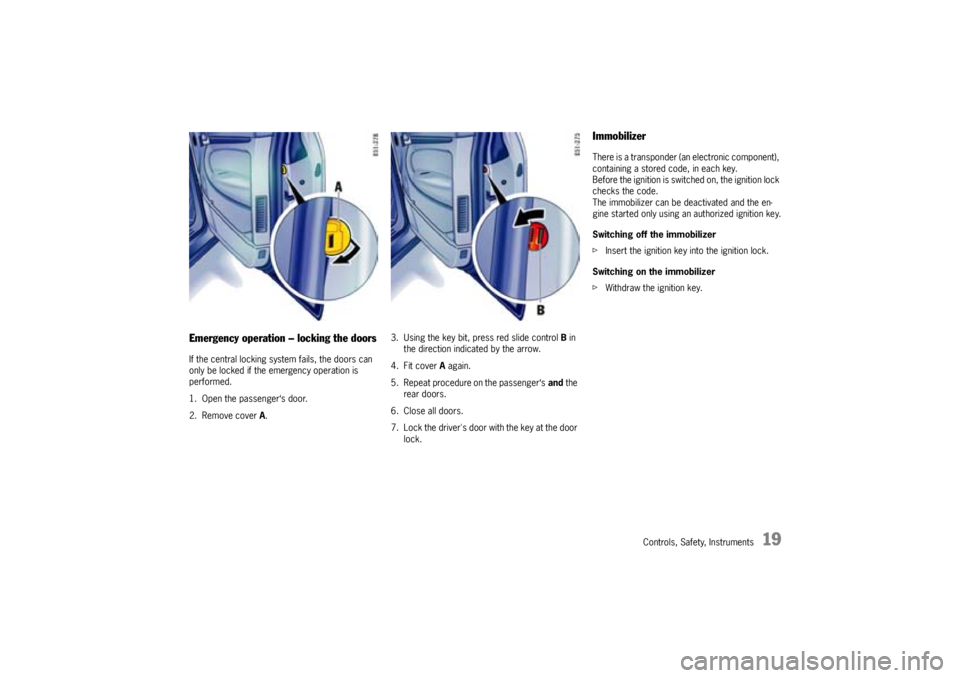PORSCHE CAYNNE S 2005 1.G User Guide
Manufacturer: PORSCHE, Model Year: 2005, Model line: CAYENNE S, Model: PORSCHE CAYENNE S 2005 1.GPages: 380, PDF Size: 3.17 MB
Page 11 of 380

Controls, Safety, Instruments
11 Controls, Safety, Instruments
Keys ............................................................ 17
Central Locking System ................................ 21
Porsche Entry & Drive ................................... 24
Doors .......................................................... 26
Alarm System, Ultrasound Passenger Compart-
ment Monitoring System, Inclination Sensor .... 27
Power Windows ............................................ 29
Front seats................................................... 32
Front seat with memory................................. 33
Easy Entry Function ...................................... 35
Headrests .................................................... 36
Rear Seats ................................................... 37
Heated Seats – Front and Rear ...................... 40
Safety Belts.................................................. 42
Child Restraint Anchorages ............................ 46
Child Restraint Systems ................................ 47
Airbag Systems ............................................ 49
Steering Wheel ............................................. 52
Multi-Functional Steering Wheel ...................... 54
Interior Mirror ............................................... 56
Door Mirrors................................................. 56
Automatic Anti-Dazzle Mirror .......................... 58
Ignition Lock/Steering Lock ........................... 59
Starting and Stopping the Engine ................... 61
Parking Brake ............................................... 64
Brakes ......................................................... 65
Instrument Panel USA Models ........................ 70
Instrument Panel Canada Models.................... 72
Oil Temperature Gauge ................................. 74
Cooling System ............................................ 75
Fuel ............................................................. 76
Odometer .................................................... 76Clock ........................................................... 77
Voltmeter ..................................................... 78
Emission Control........................................... 79
Multi-Purpose Display .................................... 80
Warning Lights and Warning Messages ......... 108
Light Switch ............................................... 116
Instrument Illumination ................................. 118
Automatic Headlight Beam Adjustment ......... 118
Turn signal/High Beam/
Headlight Flasher Stalk ................................ 119
Emergency flasher ...................................... 120
Windshield Wiper/Washer Stalk .................... 121
Cruise Control ............................................ 124
Vents ......................................................... 127
Fresh-air intake ........................................... 127
Heated Rear Window ................................... 128
Manual Air Conditioning ............................... 129
Automatically Controlled
Two-Zone Air Conditioning ........................... 132
Automatically Controlled
Four-Zone Air Conditioning ........................... 136
Parking Heater............................................ 142
Sun Visors .................................................. 147
Sun Blinds, Rear Side Windows .................... 148
Interior Lighting .......................................... 149
Door-Surrounding Lighting ........................... 151
Coming Home Function (Off Delay) ............... 151
Sliding/Lifting Roof ..................................... 152
Parking Aids ............................................... 162
Garage Door Opener ................................... 167
Ashtray ...................................................... 170
Cigarette Lighter......................................... 171Car Audio Operation/Tips ............................ 172
Porsche Communication
Management (PCM) ..................................... 174
Storage...................................................... 176
Cupholder .................................................. 180
Rear Lid ..................................................... 182
Rear Window .............................................. 184
Engine Compartment Lid ............................. 184
Loadspace ................................................. 186
Luggage Compartment Cover ...................... 187
Luggage Safety Net ....................................189
Ski Bag ...................................................... 191
Roof Transport System................................ 193
Trailer Coupling .......................................... 194
Loading Information ....................................195
Page 12 of 380

12
Controls, Safety, Instruments
Dear Porsche OwnerA lot has gone into the manufacture of your
Porsche, including advanced engineering, rigid
quality control and demanding inspections. These
engineering and safety features will be enhanced
by you...the safe driver...– who knows his car and all controls,
– who maintains the vehicle properly,
– who uses driving skills wisely and always
drives within her/his own capabilities and the
level of familiarity with the vehicle.
You will find helpful hints in this manual on how to
perform most of the checks listed on the following
pages. If in doubt, have these checks performed
by your authorized Porsche dealer.
Before driving off...Check the following items firstfTurn the engine off before you attempt any
checks or repairs on the vehicle.
fBe sure the tires are inflated correctly.
Check tires for damage and tire wear.
fSee that wheel bolts are properly tightened
and not loose or missing.
fCheck engine oil level, add if necessary. Make
it a habit to have engine oil checked with every
fuel filling.
fCheck all fluid levels such as windshield wash-
er and brake fluid levels.
fBe sure the vehicle battery is well charged and
cranks the engine properly.
fCheck all doors and lids for proper operation
and latch them properly.
fCheck and if necessary replace worn or
cracked wiper blades.
fSee that all windows are clear and unobstruct-
ed.
fCheck air intake slots and area between en-
gine compartment lid and windshield are free
of snow and ice, so the heater and the wind-
shield wipers work properly.fIf a child will be riding in the vehicle, check
child seat/child seat restraint system to ensure
that restraints are properly adjusted.
fCheck all exterior and interior lights for opera-
tion and that the lenses are clean.
fCheck the headlights for proper aim, and if
necessary, have them adjusted.
fCheck under the vehicle for leaks.
fBe sure all luggage is stowed securely.
Emergency equipmentIt is good practice to carry emergency equipment
in your vehicle.
Some of the items you should have are: window
scraper, snow brush, container or bag of sand or
salt, emergency light, small shovel, first-aid kit,
etc.
Page 13 of 380

Controls, Safety, Instruments
13
In the driver's seat...fCheck operation of the horn.
fPosition seat for easy reach of foot pedals and
controls.To reduce the possibility of injury from
the airbag deployment, you should always sit
back as far from the steering wheel as is prac-
tical, while still maintaining full vehicle control.
fAdjust the inside and outside rear view mirrors.
fBuckle your safety belts.
fCheck operation of the foot and parking brake.
fCheck all warning and indicator lights with igni-
tion on and engine not running.
fStart engine and check all warning displays for
warning symbols.
fNever leave an idling car unattended.
fLock doors from inside, especially with chil-
dren in the car to prevent inadvertent opening
of doors from inside or outside. Drive with
doors locked.
On the road...fNever drive after you have consumed alcohol
or drugs.
fAlways have your safety belt fastened.
fAlways drive defensively.
Expect the unexpected.
fUse signals to indicate turns and lane changes.
fTurn on headlights at dusk or when the driving
conditions warrant it.
fAlways keep a safe distance from the vehicle in
front of you, depending on traffic, road and
weather conditions.
fReduce speed at night and during inclement
weather.
Driving in wet weather requires caution and re-
duced speeds, particularly on roads with
standing water, as the handling characteristics
of the vehicle may be impaired due to hydro-
planing of the tires.
fAlways observe speed limits and obey road
signs and traffic laws.
fWhen tired, get well off the road, stop and take
a rest. Turn the engine off. Do not sit in the ve-
hicle with engine idling.
Please observe the chapter “ENGINE EX-
HAUST” on Page 6.fWhen parked, always put the handbrake on
and put the gearshift lever in neutral or the se-
lector lever in position P.
On hills also turn the front wheels toward the
curb.
fWhen emergency repairs become necessary,
move the vehicle well off the road. Turn on the
emergency flasher and use other warning de-
vices to alert other motorists. Do not park or
operate the vehicle in areas where the hot ex-
haust system may come in contact with dry
grass, brush, fuel spill or other flammable ma-
terial.
fMake it a habit to have the engine oil checked
with every fuel filling.
Page 14 of 380

14
Controls, Safety, Instruments
Break in hints for the first
2,000 miles (3,000 kilometers)The following tips will be helpful in obtaining opti-
mum performance from your new Porsche.
Despite the most modern, high-precision manufac-
turing methods, it cannot be completely avoided
that the moving parts have to wear in with each
other. This wearing-in occurs mainly in the first
2,000 miles (3,000 km).Therefore:fPreferably take longer trips.
fAvoid frequent cold starts with short-distance
driving whenever possible.
fAvoid full throttle starts and abrupt stops.
fDo not exceed maximum engine speed of
4,200 rpm (revolutions per minute).
fDo not run a cold engine at high rpm either in
Neutral or in gear.
fDo not let the engine labor, especially when
driving uphill. Shift to the next lower gear in
time (use the most favorable rpm range).
fNever lug the engine in high gear at low
speeds. This rule applies at all times, not just
during the break-in period.fDo not participate in motor racing events,
sports driving schools, etc. during the first
2,000 miles (3,000 kilometers).
There may be a slight stiffness in the steering or
other controls during the break-in period which will
gradually disappear.
Break in brake padsNew brake pads and discs have to be “broken in“,
and therefore only attain optimal friction when the
car has covered several hundred miles or km.
The slightly reduced braking ability must be com-
pensated for by pressing the brake pedal harder.
This also applies whenever the brake pads and
brake discs are replaced.New tiresNew tires do not have maximum traction. They
tend to be slippery.
fBreak in new tires by driving at moderate
speeds during the first 60 to 120 miles (100
to 200 km). Longer braking distances must be
anticipated.
Engine oil consumptionDuring the break-in period oil consumption may be
higher than normal.
As always, the rate of oil consumption depends on
the quality and viscosity of oil, the speed at which
the engine is operated, the climate and road con-
ditions, as well as the amount of dilution and oxi-
dation of the lubricant.
fMake a habit of checking engine oil with every
fuel filling, add if necessary.
fPlease observe the chapter “ENGINE DATA” on
Page 356.
Page 15 of 380

Controls, Safety, Instruments
15
1 Filler flap release
2 Rear lid release
3 Power windows
4 Inner door handle
5 Door mirror adjustment
6 Engine compartment lid release
7 Parking brake
8 Diagnostic socket
9 Parking brake release
10 Ignition lock/steering lock
11 Steering wheel adjustment
12 Seat adjustment
13 Instrument lighting knob
14 Light switch
15 Turn signal/high, low beam/headlight flasher
stalk
16 Operating lever for cruise control
17 Rocker switches for Tiptronic
18 Horn
19 Emergency flasher switch
20 Glove compartment
Page 16 of 380

16
Controls, Safety, Instruments
Never invite car theft!An unlocked car with the key in the ignition lock in-
vites car theft.
A steering wheel lock and a gong alarm are stan-
dard equipment in your Porsche. The gong alarm
will sound if you open the driver's door while the
key is still in the ignition lock. It is your reminder to
pull the key out of the ignition lock and to lock the
doors.
Warning!
Any uncontrolled movement of the vehicle
may result in serious personal injury and
property damage.
Never leave your vehicle unattended with the
key in the ignition lock, especially if children
and/or pets are left unattended in the vehi-
cle. They can operate power windows and
other controls. If the engine is left running,
they may accidentally engage the shift lever.
fAlways remove the ignition key.
fAlways set the parking brake.
fLock the doors with the key or with the remote control.
Warning!
Risk of a serious accident.
The steering column will lock when you re-
move the key while you are driving or as the
car is rolling to a stop. You will not be able to
steer the car.
fNever remove the key from the steering lock while you are driving.To protect your vehicle and your possessions
from theft, you should always proceed as fol-
lows when leaving your vehicle:
fClose windows.
fClose sliding/lifting roof or Panorama Roof
System.
fRemove ignition key (switch ignition off in vehi-
cles that have Porsche Entry & Drive).
fEngage steering lock.
fLock storage tray between the front seats and
glove compartment.
fRemove valuables (e.g. car documents, radio
control module, telephone, house keys) from
the car.
fLock doors.
fLock the glove compartment.
fClose oddment trays.
fCover luggage compartment with the luggage
compartment cover.
fClose rear lid and rear window.
Page 17 of 380

Controls, Safety, Instruments
17
A-Car key
B- Release button for key bitKeysTwo car keys with integrated remote control are
supplied with your Porsche. The car keys are de-
signed as folding keys.
These keys operate all the locks on your vehicle.
fBe careful with your car keys: do not part with
them except under exceptional circumstances.fInform your insurance company of any loss or
theft of car keys or if extra or replacement
keys have been made.
fRemove the ignition key, even if leaving the ve-
hicle only briefly.
Folding out the key bit
fPress release button B.
The key bit folds out.
Folding in the key bit
fPress release button B and fold in the key bit.
Replacement keysCar keys can only be ordered through an autho-
rized Porsche dealer. Sometimes, this may take a
long time.
You should therefore always keep a spare key on
your person. Keep it in a safe place (e.g. wallet),
but under no circumstances in or on the vehicle.
The key codes of new keys have to be “reported”
to the vehicle control module by your authorized
Porsche dealer. All keys belonging to the vehicle
must also be reported again.
Note
Third parties can continue to operate the mechan-
ical locks using the lost key.
Panic buttonIn dangerous situations or when one's own safety
is threatened, it is possible to draw attention to
the situation by triggering an alarm.
To trigger an alarm
fPress button.
The horn sounds and the emergency flashers
flash.
To stop the alarm
fPress button again.
The horn becomes silent and the emergency
flashers go out.
Page 18 of 380

18
Controls, Safety, Instruments
Emergency operation – pulling out the
ignition keyIf the vehicle battery is dead, the key can only be
pulled out of the ignition lock if the emergency op-
eration is performed.
1. Remove the cover (arrow) using the screwdriv-
er from the tool kit.2. Using a pointed object, e.g. a ball-point pen,
press into opening A beside the ignition lock
and keep it pressed.
3. Turn ignition key counter-clockwise.
4. Remove ignition key.
Page 19 of 380

Controls, Safety, Instruments
19
Emergency operation – locking the doorsIf the central locking system fails, the doors can
only be locked if the emergency operation is
performed.
1. Open the passenger‘s door.
2. Remove cover A.3. Using the key bit, press red slide control B in
the direction indicated by the arrow.
4. Fit cover A again.
5. Repeat procedure on the passenger‘s and the
rear doors.
6. Close all doors.
7. Lock the driver's door with the key at the door
lock.
ImmobilizerThere is a transponder (an electronic component),
containing a stored code, in each key.
Before the ignition is switched on, the ignition lock
checks the code.
The immobilizer can be deactivated and the en-
gine started only using an authorized ignition key.
Switching off the immobilizer
fInsert the ignition key into the ignition lock.
Switching on the immobilizer
fWithdraw the ignition key.
Page 20 of 380

20
Controls, Safety, Instruments
Unlocking vehicle doorsfBriefly press button 1 on the remote control.Locking vehicle doorsfBriefly press button 1 on the remote control.
Unlocking rear lid, rear window and spare
wheel bracketfBriefly press button 2.
Emergency flasher flashes once.
The rear lid, rear window and spare wheel
bracket can be opened with the appropriate
unlocking button.
The rear window and spare wheel bracket are
always unlocked if the rear lid is unlocked.
fPlease observe the chapter “REAR LID” on
Page 182.
fPlease observe the chapter “SPARE WHEEL”
on Page 307.
If the rear window is not opened, both the rear lid
and rear window will lock automatically after
30 seconds.
Note on operation
You can select the various options for unlocking
the doors, rear lid and rear window on the multi-
purpose display in the instrument panel.
fPlease observe the chapter “COMFORT” on
Page 103.
Opening the rear windowfPress button 2 for approx. two seconds.
The rear window pops open.